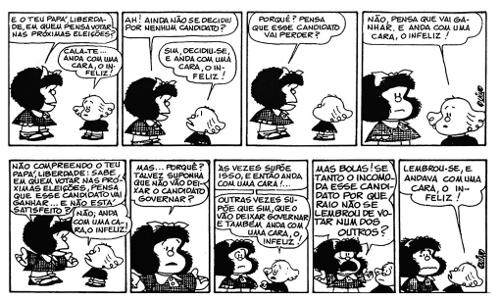You know Mafalda? Certainly, at some point in your life, you must have met this very smart and opinionated Argentine girl. The cartoonist Quino's comic has been circulating in books and newspapers for almost fifty years, and is a success among old and new fans, making its presence felt in various selection processes around the world. Who has never had to interpret the girl's avant-garde thinking in a test? His captive presence is always a great opportunity for us to reflect on society and its customs.
Mafalda was born from the hands of her creator, Joaquín Salvador Lavado – Quino – with a specific objective: to illustrate the advertising of an appliance brand that ended up not being shown. The year was 1962 and, for this reason, many confuse the girl's true age, but the first comic strip of the character was only officially published in the year of 1964, more precisely on the 29th of September. The setting for Quino's stories are the neighborhoods of Montserrat – a place that received a square to honor Mafalda – and San Telmo, in the Argentine capital, Buenos Aires. So the fifty years of the little notable will be celebrated now, in 2014, but it's always time to revisit the comic strips and celebrate its existence.

Mafalda became an icon of the 70s, provoking pertinent discussions, such as social inequalities and sexism
Quino made his debut in 1963 with the publication of the first album called Quino World. But the real success came with Mafalda, which in 1965 started to be published daily in the newspaper World, from Buenos Aires. Thanks to the girl with a red ribbon in her hair, Quino was elevated to the rank of one of the greatest graphic humorists in the country. But what makes Mafalda such a charismatic and different character in the world of comics? The girl, despite being only six years old, is absolutely precocious and served as a spokesperson for her creator in times of an implacable Military Dictatorship in Argentina. She had unusual concerns for children her age, seeing life from a peculiar perspective as she approached pertinent issues through acidic and extremely ironic language.
Do not stop now... There's more after the advertising ;)
In 1967, the success of the Mafalda strips was already consolidated, which allowed them to survive despite the newspaper's bankruptcy World, being later published in the weekly Siete Illustrated Days. Nine years after the inaugural publication, Quino decided not to draw the character's stories anymore, as the comics needed to be delivered with some time in advance for publication and, therefore, he could no longer comment on everyday matters, another striking feature of the speech of Mafalda. Quino preferred to retire the character, but the public did not do the same, elevating Mafalda to the position of icon of a generation, a true symbol of the 70s, times marked by great cultural and politics. Despite being fifty years old, some strips are absolutely up-to-date, denoting that, unfortunately, we still need to go a long way so that Mafalda is dated, thus losing a little of the sense that still does. We are sure she would be very happy to hear that her arguments have become outdated. For now, they remain relevant and timeless. Below, we have selected for you two strips that illustrate well the thinking of the most politicized girl in Latin America. Happy reading and good thinking!

Spokesperson for its creator, cartoonist Quino, Mafalda dealt with pertinent themes in a dark time in Argentina's recent history

Despite its fifty years of age, Mafalda remains current, consistently reflecting old problems of our society.
By Luana Castro
Graduated in Letters
Would you like to reference this text in a school or academic work? Look:
PEREZ, Luana Castro Alves. "Fifty Years of Mafalda"; Brazil School. Available in: https://brasilescola.uol.com.br/redacao/cinquenta-anos-mafalda.htm. Accessed on June 27, 2021.


